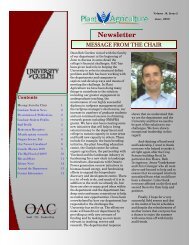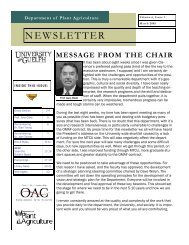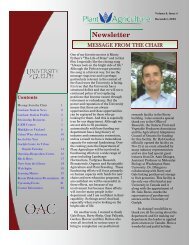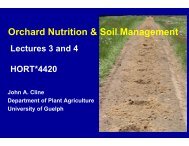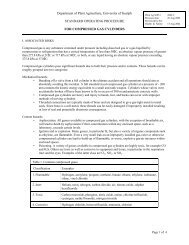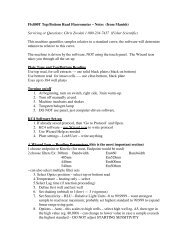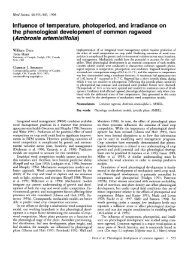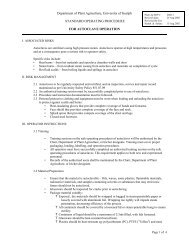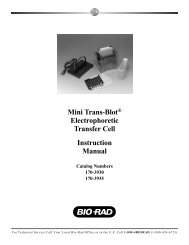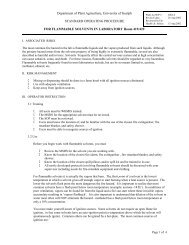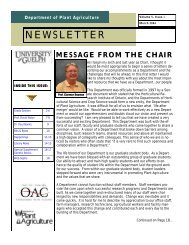Columnar Peach Trees Grown using High Density ... - Plant Agriculture
Columnar Peach Trees Grown using High Density ... - Plant Agriculture
Columnar Peach Trees Grown using High Density ... - Plant Agriculture
Create successful ePaper yourself
Turn your PDF publications into a flip-book with our unique Google optimized e-Paper software.
<strong>Columnar</strong> <strong>Peach</strong> <strong>Trees</strong> <strong>Grown</strong> <strong>using</strong> <strong>High</strong> <strong>Density</strong> Orchard Systems<br />
April, 2003<br />
Dr. John A. Cline and Debbie Norton, Dept. of <strong>Plant</strong> <strong>Agriculture</strong>, University of Guelph<br />
Dr. Scorza and co-workers of the United States Department of <strong>Agriculture</strong>,<br />
Kearneysville, West Virginia, have developed peach trees with more upright growth<br />
habits - referred to as ‘columnar’ trees. The purpose of this research is to provide trees<br />
that have characteristics more favourable for higher densities orchard systems.<br />
In Ontario, peach trees are commonly planted at approximately 150-200 trees per acre<br />
<strong>using</strong> a free-standing open canopy/vase system. For the development of high density<br />
peach production systems <strong>using</strong> traditional cultivars, severe pruning is necessary.<br />
However, pruning invigorates trees and leads to excessive vegetative growth which can<br />
adversely affect fruit quality and flower bud formation because of shading.<br />
A more upright tree form should reduce the need for extensive pruning when planted at<br />
closer spacings. The columnar form is a cylindrical-shaped tree which produces many<br />
side branches with an upright, apically dominant growth tendency. The appearance of<br />
the columnar trees resembles a fusetto/spindle trained tree.<br />
The upright form was derived by crossing columnar with standard trees. Since tree habit<br />
is determined by the cultivar rather than rootstock, breeders have been challenged with<br />
trying to modify habit without sacrificing fruit quality. Improvements in fruit quality and<br />
horticultural characteristics, that now nearly emulate commercial cultivars, have resulted<br />
in the release of KV930455 (columnar form) (Figure 2) and KV930278 (upright form).<br />
‘Sweet-N-UP’ is the first upright peach tree named by the USDA. It produces fruit of<br />
excellent quality. Fruit are sweet and flavourful, have bright red blush covering 80% of<br />
the fruit surface over a bright yellow background. Fruit size averages 2.75 to 3.0 inches<br />
in diameter . Fruit ripen in mid August (‘Loring’ season) and the flesh is yellow<br />
freestone and firm, smooth and melting.
Figure 11. Schematic showing different peach tree forms. ST = Standard; UP = upright<br />
form (ie, KV930278 named ‘Sweet-N-Up’), PI= Pillar/<strong>Columnar</strong> Form (KV 870455)<br />
Figure 2. Two-year-old columnar peach<br />
‘KV930455' on ‘Bailey rootstock’ growing at the<br />
University of Guelph, Vineland Campus<br />
Current Research in Vineland<br />
In order to examine the feasability of growing upright peach forms commercially in<br />
Ontario, Drs. Neil Miles and John Cline initiated an experiment in 2001 at the University<br />
of Guelph, Vineland Campus. The purpose of this project is to compare peach trees<br />
with standard (HW261), intermediate (Babygold 5), upright (‘KV930278' - recently<br />
named ‘Sweet-N-Up’) and columnar growth forms (‘KV930455'). All trees are planted<br />
on Bailey rootstock. Each cultivar is trained to either a ‘Fusetto’ (spindle) system<br />
(planted 1.2 m within x 4.5 m between rows; 1851 trees/ha or 750 trees/acre) or central<br />
leader system (planted at 2.0 m within x 4.5 m between rows; 1111 trees/ha or 462
trees/acre). Standard cultural practices for the Niagara Region, including mineral<br />
nutrition, IPM, fruit thinning etc. are being used. Permanent sod is established between<br />
rows and woodchip mulch is used within the drip-line for weed control and to enhance<br />
soil moisture levels.<br />
Preliminary Results (Table 1)<br />
The first year of fruiting was 2002. A number of parameters were measured included:<br />
tree trunk cross sectional area, tree height, number of pruning cuts, and fruit set, total<br />
yield, total number of fruit and mean fruit weight. This is a long term study focussing on<br />
differences in yield, fruit size, fruit quality and labour requirements between the four tree<br />
forms.<br />
In 2002, the second year of the trial, trees of both the upright (Sweet-N-Up) and<br />
columnar (KV930455) form were already exhibiting their natural shape and were the<br />
tallest and narrowest, followed closely by the intermediate form (Babygold 5). The<br />
standard form (HW261) was shorter than the other three cultivars. Trunk cross<br />
sectional area (TCA) was similar for columnar, upright and intermediate forms but the<br />
TCA for the standard form was about 30 % smaller than the others. The results were
similar for both training systems (Fusetto vs Central Leader).<br />
The amount of pruning required was impacted by both tree form and training system.<br />
Under the central leader system, the intermediate form required the most pruning, while<br />
the standard required the least. It is anticipated that as the trees mature the standard<br />
form will require more ‘containment’ pruning to keep it confined to its allotted spacing.<br />
Under the Fusetto training system, the standard form required the most pruning<br />
followed by the intermediate form. The columnar and upright forms required the least<br />
amount of pruning. Fruit yield was light in 2002, the first year of production. It is too<br />
early in the project to draw conclusions about yield, but the upright form (Sweet-N-Up)<br />
produced the highest yield in both training systems and had an average fruit weight of<br />
about 175 grams. Fruit quality was quite acceptable.<br />
As this study continues, it will provide insightful information on the practical benefits of<br />
high-density columnar and upright trees for commercial peach growers.<br />
We gratefully acknowledge the financial support of the Niagara Peninsula Fruit and<br />
Vegetable Growers Association and the Ontario Ministry of <strong>Agriculture</strong>, and for the<br />
assistance of Rocco Guarnaccia and Darcia Fraser.




